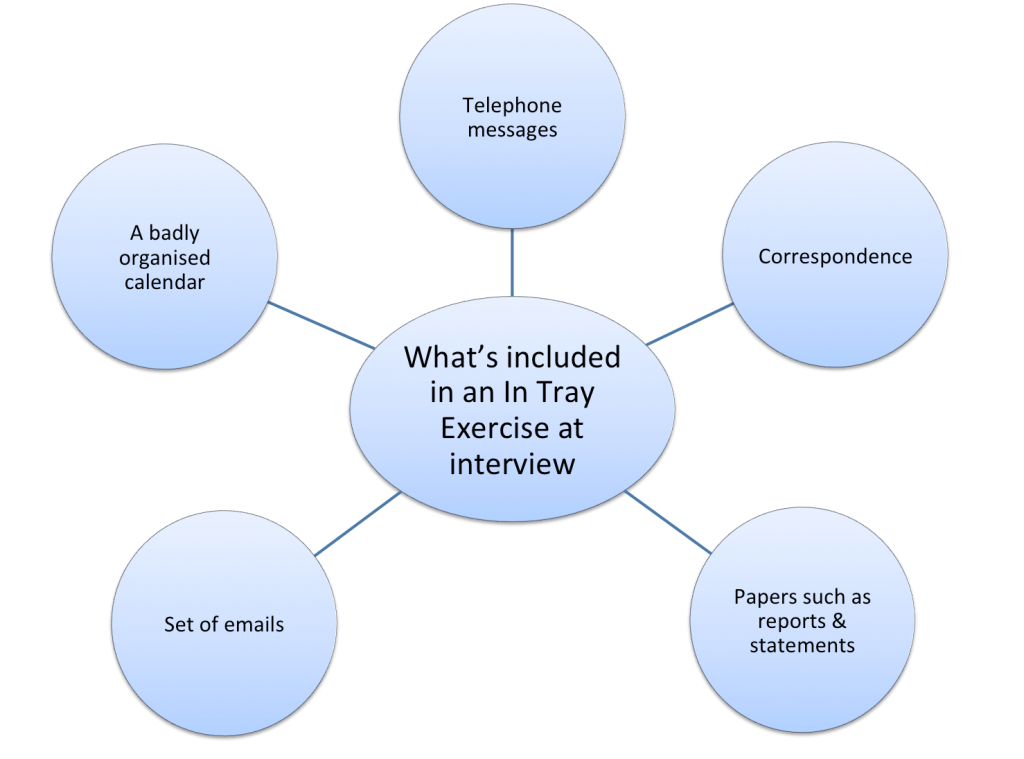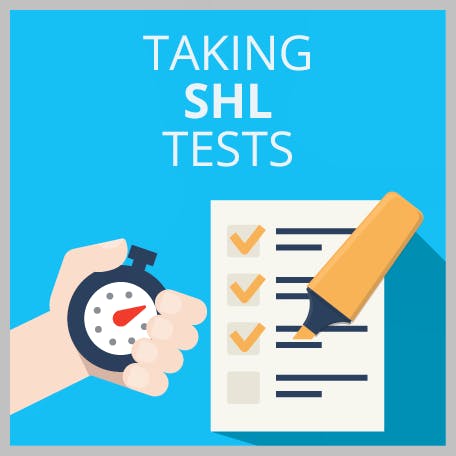In-Tray & E-Tray Exercises, Prep Guide 2025
Updated November 18, 2023


The in tray exercise (also called an e-tray exercise) is a popular assessment activity which employers use to evaluate the skills of applicants in a workplace situation.
If you have an In Tray exercise coming up as part of your interview process, this article will help you prepare.
Within these exercises, candidates will be presented with a given scenario, along with a set of tasks to complete which may include things like responding to email messages, reports or briefing documents.
The exact activities will depend on the nature of the role you are interviewing for.
The applicant is required to review the scenario and then work through the tasks, prioritising accordingly and providing an explanation for their system of prioritisation.
Bonus: Get free unlimited access to test practice (for 30 minutes) on our partner website JobTestPrep.
What is an In Tray Exercise?
In tray exercises can vary considerably in terms of their duration, with some as little as 30 minutes while others are as long as 2 hours.
During the exercise it is not uncommon to be asked to progress through between ten and thirty items, so working quickly and accurately is crucial.
You may also be presented with a collection of supplementary information to help you complete the exercise, which could include:
- A description of the role and responsibilities of the organisation
- Information about aims, objectives
- The organisational structure
- A list of employees
- Schedule of events/projects
- Details about third party organisations and relationships

A Summary of What Is Included in an in Tray Exercise at Interview
In tray exercises are not restricted to a particular role or a specific sector; they are frequently used in a number of different sectors and can be used for several types of jobs from an Administrative Assistant to an IT Support or Finance Officer.
A typical in tray exercise will set a scenario similar to:
It’s Friday morning, work has gradually built up over the course of the week and you have an important meeting at 09:30am. You have a number of tasks on your desk to complete and you have 30 minutes in which to prioritise and complete each of the tasks.
You will then be presented with a list of tasks which may include a combination of the following:
- Telephone messages
- Correspondence
- Papers such as reports, statements, briefing documents and plans
- A set of emails
- Planner or Calendar
The subject matter of the in-tray exercise will usually relate to the role you have applied for.
So for example, if you are in marketing it may include a telephone message from a design team, correspondence from a customer, a marketing brief or strategy, emails to and from the client and a marketing schedule.
You will then have a certain amount of time to read through the information you have been given
and then prioritise each task as you would on an average day in the workplace.
Once the tasks have been prioritised, you will be expected to explain the action required and how you would deal with the situation.
This could be returning a call, delegating a task to another member of staff, scheduling in a meeting or drafting a response to a letter.
In-Tray Exercise Tips
Step 1. Read All the Information
Before you begin thinking about how you are going to prioritise the tasks, firstly read through all of the information that you have been provided with, paying particular attention to any instructions for the activity.
Step 2. Act Naturally
When you are ready to start, approach the exercise as though you were at work on an average day and the tasks had landed on your desk.
Step 3. Remain Calm
Try to remain calm and think through the situation logically, identifying the most important tasks as a starting point.
Step 4. Write Notes and Use Paper
It may be beneficial to jot down your initial thoughts on a piece of paper before you provide your final answers so you can rearrange the order of the items if necessary.
Review any deadlines which accompany the tasks so you can take these into consideration when preparing your final list.
Time can go very quickly during an in-tray exercise so you need to think and act quickly, but you have to be careful not to rush so you don’t make silly mistakes.
It is crucial that you don’t overlook a key piece of information which can result in misinterpreting the activity completely or failing to carry out a vital task that you have been asked to complete.
You will be assessed on your ability to work effectively under pressure and also your capacity to identify whether certain tasks are more important than others.
You can find an example of an In Tray Exercise Time Management game on elitetraining.co.uk.
How the In Tray Exercise Is Assessed
Irrespective of the topics or the job role, the in tray exercise will be used to assess your ability to synthesise, analyse and evaluate complex information within tight time constraints.
Recruiters will be looking at how you arrive at your answers and how effectively you can communicate your reasons for choosing certain options, overcoming problems and addressing any issues along the way.
You will also be assessed on how well you communicate your thought processes.
It is always important to pay attention to how you present yourself during these exercises so take care to organise your workstation as best you can, present your work as neatly as possible, and approach the task calmly and confidently.
In some in-tray exercises you may be expected to identify a certain theme as you work through the content. Something like the imminent merger of the company or a period of restructuring.
Identifying themes such as these will show that you really understand the role and explain how this has influenced the way in which you have prioritised the tasks and evaluated the information.
How In Tray Exercises are Evolving
As businesses rely more on technology to carry out their work, applicants are increasingly asked to carry out an e-tray exercise.
Very similar in nature to the traditional in-tray assessment, the documents are provided in a folder on a computer rather than being presented in paper format.
To pass an in-tray exercise you’ll need to show a range of core competencies like time management, organization, communication and decision making.
You’ll also need a good understanding of the job you’ve applied for and the role it plays in the business.
Do plenty of research on the position and hiring organization before you complete your in-tray exercise.
On the day, read instructions and supporting documents carefully, stay calm and approach the situation just as you would in a real world work environment.
In-tray and e-tray exercises are designed to simulate the real demands of a job and are not intended to be so complex that they are difficult to pass.
They do however ask a lot of you in a short space of time. Combine this with the fact you’re likely to be a little nervous, and these assessments can be challenging if you’re not fully prepared.
Complete plenty of practice in-tray exercises before test day to boost your confidence.
There are plenty of resources available online to help you prepare for your in-tray or e-tray exercise.
These include practical tips on how to approach the assessment, and example questions that let you put those tips to the test, like our own practice in-tray exercise.
Remember that your own assessment will be based on the role you’ve applied for, so you should also research what that job entails as part of your preparation.
In-tray and e-tray exercises help employers judge how well you’ll handle your responsibilities if offered the role, and each hiring team will have a level of competence it expects you to meet.
If you perform below this standard on your in-tray or e-tray exercise you’ll jeopardize your success in the selection process.
Whilst not technically a fail, you want to do all you can to avoid this situation, so make sure you’re fully prepared.
It is unlikely the hiring organization will let you retake your in-tray or e-tray exercise unless extenuating circumstances apply.
Just as with any stage of the selection process you get one chance to prove you’re a strong candidate, so make the most of it.
You can find sample questions for in-tray and e-tray exercises on sites like Practice Reasoning Tests and JobTestPrep.
Along with the sample questions themselves you’ll also find practical tips on how to approach them and suggested answers with detailed explanations.
The main purpose of an in-tray or e-tray exercise is to assess your core competencies and workplace behaviors in a practical context.
Employers use these work based simulations to see how you manage your workload, define priorities and communicate with co-workers, among other things.
The exercises are commonly completed as part of an assessment center along with other role play and group tasks, giving employers a well rounded picture of your professional abilities.
In-tray and e-tray exercises are timed assessments. Durations vary, and a single test can last anywhere from 30 minutes to two hours.
This restriction means you’ll need to apply keen time management, which is one of the key skills under assessment.
In-tray and e-tray exercises are a reliable indicator of future work performance, and can be tailored to a wide range of office based job roles.
This makes them popular with employers in many industries.
Some notable companies and organizations that use these exercises include the NHS, the UK Civil Service, Citi Group, Deloitte, Accenture and KPMG.
There is no standard format for in-tray and e-tray exercises, so the number of questions you’ll face will depend entirely on the test’s design.
There will also be a combination of multiple-choice questions and written tasks for you to complete, and you should aim to do so comfortably within the given timeframe.
JobTestPrep offers a comprehensive preparation guide for in-tray and e-tray exercises.
In this you’ll find sample scenarios with sample tasks to complete, explanations for every question, and practical tips for success.
It’s a valuable resource for your in-tray exercise preparation that will help you build the skills and confidence you need to perform well on the day.
The Deloitte E-Tray exercise is a part of the Deloitte graduate recruitment process. It is an assessment tool used by Deloitte and many other organizations as a way to evaluate candidates' skills and competencies in a simulated work environment.
The E-Tray exercise typically assesses a candidate's ability to manage their time, prioritize tasks, make decisions, and communicate effectively.
Conclusion
However the in-tray exercise is structured, it is really important that you are calm and collected in your approach.
This will ensure that you make the best decisions with the available information and you won’t overlook anything significant.
With an in-tray exercise there are no right or wrong answers. Recruiters will simply be looking for how you organise your work and your reasoning behind prioritising each task presented in the in-tray exercise.
For more tips and hints, be sure to check out the YouTube video below or take a look at this super useful guide from Enterprise Rent-a-car
Need more practice? Try practice tests from JobTestPrep.












